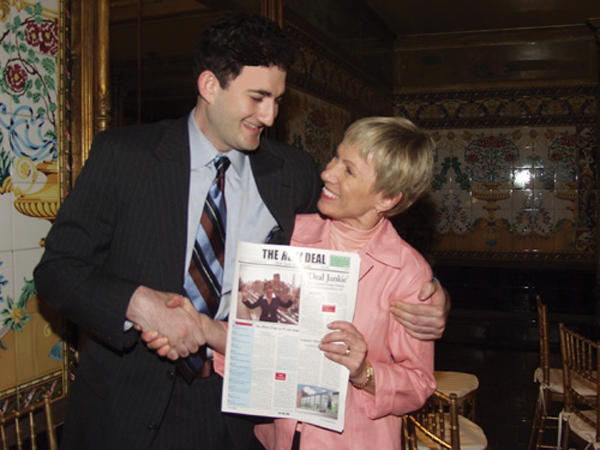
It may be hard for some to imagine now, but there was a time when Columbus Circle was gritty, Williamsburg was more Hasidic than hipster and west of 10th Avenue was a no-man’s-land.
Over the past 17 years, The Real Deal has churned out 250 issues, chronicling the changing real estate landscape — from the slew of supertalls on Billionaires’ Row to the WeWork saga and everything in between. In that time, this publication has won more than 40 awards while covering the industry’s highs and lows across four major U.S. markets.
TRD’s first issue was pieced together in publisher Amir Korangy’s Brooklyn apartment in the spring of 2003, before our budding magazine and website moved into its first Manhattan office on East 23rd Street the following year. More than a decade later, we settled into new digs in Hudson Yards, a neighborhood that didn’t exist 13 years prior.
During that time, New York City real estate has traced the arc of U.S. history: the rebuilding of Lower Manhattan after 9/11, the housing crash and Great Recession, and developer Donald Trump’s stunning presidential win — which sparked progressive movements across the country.
In the past 15 months New York saw Amazon abandon Long Island City, a power shift in Albany and a new rent law that shocked the multifamily market.
As with most media companies, we underestimated the reckless lending that led to a global financial crisis.
“Luckily, we didn’t have to make any layoffs during that period,” TRD’s editor-in-chief, Stuart Elliott, said in a recently recorded conversation with Korangy.

Amir Korangy meets with Barbara Corcoran during The Real Deal’s (very) early days.
During and after the euphoric market leading up to 2007, this publication homed in on inflated real estate sales in the Big Apple, including $1.4 billion for the General Motors building and $7 billion for an office portfolio by Harry Macklowe, $5.4 billion for Stuyvesant Town–Peter Cooper Village by Tishman Speyer and BlackRock, and $1.8 billion for 666 Fifth Avenue by Kushner Companies, then led by Jared Kushner.
The fates of those record-breaking deals came to epitomize the cutthroat market after Lehman Brothers collapsed. In the years that followed, TRD chronicled the Macklowe family’s spats, which blurred the line between personal and business: Kent Swig and Elizabeth Macklowe’s acrimonious split, the fallout between Harry and his son, Billy, and Harry’s epic divorce from Linda after 50 years.
In the same time span, Manhattan condos overtook co-ops as the gold standard for city’s luxe-apartment market. That was cemented in 2011, when former Citigroup chairman Sanford Weill sold his penthouse at 15 Central Park West for a record $88 million.
Intense competition on Billionaires’ Row followed. Within months of its sales launch the same year, Extell Development sold 50 percent of its One57 units for $1 billion. And in late 2014, Michael Dell paid $100.5 million for its best penthouse. Then in January 2019, hedge funder Ken Griffin shattered Dell’s record with a $238 million deal to buy a sprawling aerie at 220 Central Park South.
The luxury condo market peaked in the mid-2010s as foreign buyers helped fuel sales. But geopolitical shifts have weakened their purchasing power, and unsold inventory has piled up, despite pricey purchases by such American bigwigs as Griffin and Jeff Bezos. And as U.S. regulators increasingly eye anonymous purchases, TRD has traced the flow of illicit funds into real estate.
In 2015, Malaysian investor Jho Low came to symbolize the way the industry relies on “dirty money” after it was revealed he used his country’s 1MDB development fund to invest in the Park Lane Hotel and luxury condos. Even after agreeing to give up $1 billion, Low remains a fugitive.

Donald Trump Jr. leads a tour of a Trump project as Stuart Elliott takes notes.
The past 17 years have also brought seismic shifts in residential brokerage — from the launch of StreetEasy and Compass to the closing of Town Residential — and in the city’s retail, hotel and office markets.
When our first issues printed, Soho and Madison Avenue stores were bustling, the city’s office market was dominated by banks and law firms, and Amazon was purely digital. But in the past six years, store vacancies have proliferated, and Facebook, Amazon, Apple, Netflix and Google (aka FAANG) have occupied millions of square feet of office, retail and warehouse space citywide. In February 2018, TRD broke the news that Google was in contract to buy the Chelsea Market building for $2.4 billion.
WeWork wasn’t even a seed of a company when this publication debuted. In 2018, however, it became Manhattan’s largest office tenant — before the world watched it implode. “We are changing the way people work. It just happens to be that we need space to do it in,” the company’s co-founder and now-ousted CEO Adam Neumann told TRD in 2013.
WeWork’s valuation ballooned to $47 billion, largely thanks to SoftBank’s Masayoshi Son, who aggressively bet on the co-working company. Son has since poured billions into other startups, including Compass, Opendoor and Katerra, which aim to use tech to “disrupt” the real estate industry. Other venture capital funds have followed suit, pouring $24.7 billion into proptech in 2019, up from $12.7 billion in 2017, according to CRETech.
But how well those bets will pay off remains to be seen.
Last August, WeWork filed its prospectus to go public, shedding light on Neumann’s self-dealing, the company’s steep losses and its rocky path to profitability. Its valuation has since fallen to $8 billion, its IPO is dead and mass layoffs are pending.
Of course, the real estate drama will never stop.
Heading into 2020, new battle lines are being drawn between the industry and city and state officials, a wave of condo debt is coming due, and the fates of New York’s housing, office, hotel and retail markets remain anyone’s guess. With that in mind, TRD is committed to bringing our readers another 250 issues and much more.
“Through it all,” Korangy said, “one thing became abundantly clear: The only news that matters in this city is real estate news.”
